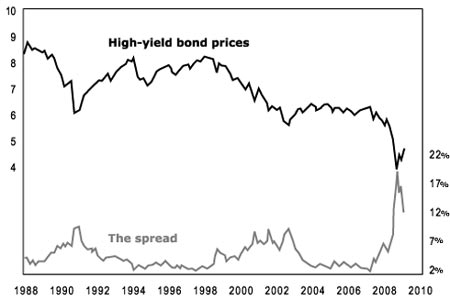
In the past two weeks, I’ve spent a considerable amount of time researching the corporate bond market.
I think it’s one of the greatest opportunities to make a substantial amount of capital gains – and earn high income – you’ll ever see.
Most individual investors have never bought a bond in their lives – at least not directly. They probably own a bond mutual fund. If they have life insurance, they have corporate bonds backing up their policies – they just don’t know it. If they’re the beneficiary of a pension fund or almost any kind of defined-benefit plan, they also are investing in corporate bonds. Again, they just don’t know it.
But most fiduciaries – pension plans, insurance companies, company treasurers, etc. – are legally barred from holding bonds that aren’t rated “investment grade” by the credit-rating agencies.
This creates a two-tiered market for debt. One, investment grade, that’s liquid and “efficient” – meaning there aren’t meaningful price-to-value discrepancies. The other market – for high-yield debt, or so-called “junk bonds” – is much less liquid and efficient.
The moment a company’s credit is downgraded below investment grade, most institutional bond investors are forced by law to sell all of the company’s bonds. It doesn’t matter how close to maturity the bonds are or how much interest coverage is available. It doesn’t matter that the company has plenty of assets to sell to cover its debt obligations. If the credit-rating agencies determine the risk of default has breached a threshold, the company is downgraded.
The credit-ratings agencies don’t publish exactly what their standards are, so it’s impossible to know which companies will be downgraded. When it happens, there isn’t enough liquidity for all of the institutional investors to sell at once without sending the price plummeting.
And that’s what’s been happening in the bond markets for about the last two years. Credit-rating agencies are downgrading bonds, and institutional investors are bailing in droves.
As you know, the price of a bond is inversely related to its coupon yield. A simple way to remember this is to remember the coupon is fixed. Since the coupon never changes, the lower the price of a bond, the higher its yield.
(For example, if a bond with a $9 annual coupon is trading at par – $100 – it would have a 9% yield. But if the price of the same bond fell in half, to $50, then its yield would increase to 18%. The coupon didn’t increase, but the value of the coupon relative to the price of the bond increased.)
Investors generally require junk bonds to pay eight to ten percentage points more than Treasuries to compensate for the extra risk of holding a less-than-investment-grade credit. That’s the “spread.”
The following chart shows the yield spread and the prices on a major bond index.
As you can see, prices on the bond index are tightly correlated to spreads. When spreads are rising, prices for junk bonds fall. When spreads are narrowing, prices for junk bonds rise.
We set a new all-time record interest-rate spread for junk bonds in early March, when the spread reached 22 percentage points. That spread has since narrowed to around 17 percentage points. That’s still quite a bit more than the previous peaks during the bear markets of 1991 and 2002.
With all the additional liquidity now coming into the market, I have no doubt junk-bond spreads will continue to narrow, sending bond prices higher. If you’d bought junk bonds around the previous peaks in the yield spread in 1991 or in 2002, you made about 50% in the following 15 months. But the yield spread is still quite a bit wider than it was back then. And the amount of fiscal and monetary stimulus is much, much larger.
According to James Grant of Grant’s Interest Rate Observer, the current monetary stimulus is “on track to be ten times greater, at least, than the average policy response to the ten preceding post-War recessions.”
This gives us an outrageous opportunity. A huge wave of new capital – the Great Re-Leveraging – will be hitting the market this year. It will go in search of yield. The best opportunity for yield is in the high-yield bond market, which is still trading at record high interest-rate spreads. The result will be like sticking a fire hose into a teacup.
The best and safest way to profit from the ongoing re-leveraging of the US economy is through bonds – particularly high-yield bonds. We stand to profit as the yield spread declines because we’re able to buy corporate bonds today with very high yields.
The Great Re-Leveraging is coming… and it will ensure bond investors make a fortune over the next year.
• This article was written by Porter Stansberry for the free daily investment letter
DailyWealth